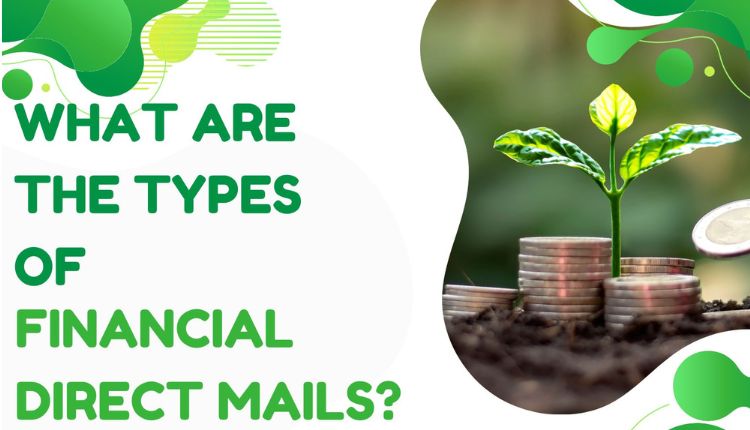
What are the Types of Financial Direct Mails?
Financial services companies rely on their reputations to attract customers. The main things that keep these businesses operating in the market are reliability, dependability, and honesty. Any financial organization that is unable to achieve these goals will probably begin to experience losses. Therefore, it is crucial that these characteristics or attributes are strongly conveyed to the public.
The conversation often becomes difficult. Reaching out to so many individuals and gaining their trust in the company is difficult.
People will only do business with organizations they see as trustworthy and whose services they regard as beneficial. Direct mail is effective in making a personal connection with the audience and conveying the message that they are important and that their input is worthwhile.
Advantages of using Financial direct mails
- Outstanding Targeting Skills
Direct mail typically uses geofencing and geo targeting, two of the most advanced digital audience targeting strategies. You may choose which carrier routes you wish to include or omit from a saturation mailing list since it targets all of the addresses inside a carrier route, which is a subset of a zip code.
- Lower Mailbox Competition
While much of the marketing world’s focus has shifted to internet advertising, you may profit from the mailboxes of your recipients being relatively uncluttered.
In contrast to the 107 emails or 63 advertisements that people view daily, the typical individual only receives 2 pieces of actual mail daily.
The physical mail that does arrive stands out as individuals receive less and less of it.
Sending eye-catching products like bigger postcards, refrigerator magnets, or even interactive mailers with scratch-off rewards or smartphone-friendly QR codes will enhance your chances of getting spotted.
- Complements Digital Marketing
The best of all worlds is possible with direct mail marketing, which is fantastic. Even if they choose to engage with you online, you may still communicate with your consumers offline. You may include QR codes, social network connections, and deals that are only available online.
Online and direct mail campaigns can complement one another because of the numerous tracking tools available for direct mail marketing. To develop a thorough multichannel marketing plan, utilize several marketing tools at each stage of the procedure.
Send a printed restaurant menu to your clients, and then immediately after, promote the same deal with display advertising on Facebook and through Google Ads.
- Increases Brand Recall and Loyalty
Many consumers still believe that direct mail is more reliable than internet advertisements. They are wary of online fraud and are more likely to believe a company with a physical location.
Direct mail marketing increases the credibility of your brand and contributes to its awareness and trust among potential customers. Use recognizable colors and logos that customers will recognize from your local retail store or other advertisements.
- The Physical Mail’s Tactile Value
The fact that our brains are still built to analyze physical objects more quickly than digital ones is what it all comes down to in the end. According to fMRI studies, tactile media can boost memory and make an event more memorable by evoking stronger emotional responses than digital media.
Emails have a lower response rate than direct mail, and anything viewed on screens is more likely to be skimmed before being forgotten.
By employing unusual sizes, weights, and interactive aspects, you may take use of people’s innate affinity for tactile sensations to leave the receivers of your mailer with a lasting impression.
Types of financial direct mail
- Letters
Letters are typically detailed and lengthy. They give comprehensive details on the many services that the company offers. For improved clarity and comprehension, financial businesses utilize this approach to explain all the fine information.
The audience reads direct mail letters as a starting point for information and decision-making. They provide a reply option for the recipients and are quite personalized.
Letters are an excellent method to generate leads, but they might be a little pricey due to the volume of pages.
- Postcards
Postcards are more compact and complete direct mail items. Compared to letters and brochures, they are more beautiful, colorful, and straightforward. Postcards are just intended to convey highlights; they are not intended to provide minute information.
Postcards may be used by banks to let customers know about their interest rates, current retirement plans, and offers—in other words, to entice people to learn more about them. Usually, there is a call to action (CTA) instructing people to phone or go to their website for further information.
Postcards are far less expensive than letters and do not offer reply mail. They serve just to increase brand recognition and encourage consumers to act. Even a little postcard may generate a lot of interest if it has compelling graphics and bullet points.
- Brochures
It can be folded one way, twice, or three times. The amount of material that financial services companies want to add might be taken into consideration while selecting from these possibilities. Brochures may be both aesthetically pleasing and instructive.
Although letters don’t have much text to read, they may still be utilized to convey adequate information when combined with beautiful pictures. Brochures can effectively combine client testimonials, real-world examples, biographies, pictures, and charts.
Conclusion
Direct mail is gaining popularity again, and financial direct mail is a part of it. With financial direct mail, finance-based companies can create a huge chunk of potential customers, as human psychology plays a big role in receiving any type of mail that you can feel physically. It creates a sense of importance, and with the help of different types of financial direct mail, this is much easier to do.




